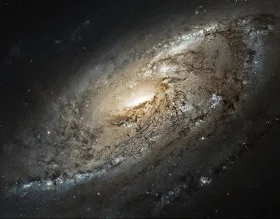Στην
νέα εικόνα του Μ106 πρωταγωνιστούν οι δύο εντυπωσιακές μπλε-μωβ σπείρες του. NGC 4258
is a spiral galaxy well known to astronomers for having two so-called anomalous
arms that glow in X-ray, optical, and radio light. Rather than being aligned
with the plane of the galaxy, they intersect with it. This composite image of
NGC 4258 shows the galaxy in X-rays from Chandra (blue), radio waves from the
VLA (purple), optical data from Hubble (yellow and blue), and infrared with
Spitzer (red). Researchers are using all of these telescopes to better
understand how the supermassive black hole is affecting the galaxy and its
anomalous arms. Credit: X-ray: NASA/CXC/Caltech/P.Ogle et al; Optical:
NASA/STScI; IR: NASA/JPL-Caltech; Radio: NSF/NRAO/VLA
Η
NASA έδωσε στη
δημοσιότητα μια νέα εντυπωσιακή εικόνα του γαλαξία Μεσιέ 106 (M106), επίσης γνωστός ως NGC 4258. Η νέα εικόνα αποτελεί σύνθεση των
νέων παρατηρήσεων που έκανε ομάδα αστρονόμων με διαστημικά και επίγεια
τηλεσκόπια. Οι ερευνητές μελέτησαν δύο άγνωστες μέχρι πρόσφατα σπείρες του Μ106
που κυριολεκτικά φωτοβολούν.
Ο
γαλαξίας
A new study of
these anomalous arms made with Spitzer shows that shock waves, similar to sonic
booms from supersonic planes, are heating large amounts of gas - equivalent to
about 10 million Suns. What is generating these shock waves? Radio data shows
that the supermassive black hole at the center of NGC 4258 is producing
powerful jets of high-energy particles. Researchers think that these jets
strike the disk of the galaxy and generate shock waves. These shock waves, in
turn, heat some of the gas - composed mainly of hydrogen molecules - to
thousands of degrees. As shown in our additional, composite image, part of the
evidence for this heating process comes from the similarity in location between
the hydrogen and X-ray emission, both thought to be caused by shocks, and the
radio jets. The Chandra X-ray image reveals huge bubbles of hot gas above and
below the plane of the galaxy. These bubbles indicate that much of the gas that
was originally in the disk of the galaxy has been heated to millions of degrees
and ejected into the outer regions by the jets from the black hole. The
ejection of gas from the disk by the jets has important implications for the
fate of this galaxy. Researchers estimate that all of the remaining gas will be
ejected within the next 300 million years - very soon on cosmic time scales -
unless it is somehow replenished. Because most of the gas in the disk has already
been ejected, less gas is available for new stars to form. Indeed, the
researchers used Spitzer data to estimate that stars are forming in the central
regions of NGC 4258, at a rate which is about ten times less than in the Milky
Way Galaxy. These results were published in the June 20th, 2014 issue of The
Astrophysical Journal Letters and are available online. The
authors are Patrick Ogle, Lauranne Lanz and Philip Appleton from the California
Institute of Technology in Pasadena, CA.
Ο
M106 βρίσκεται σε
απόσταση περίπου 22 εκ. ετών φωτός στον αστερισμό των Θηρευτικών Κυνών. Είναι
σπειροειδής γαλαξίας, του οποίου η διάμετρος υπολογίζεται σε 80.000 έτη φωτός.
Οι σπειροειδείς βραχίονές του έχουν σκούρες λωρίδες σκόνης, λαμπερά και νεαρά αστρικά
σμήνη που αποτελούνται από γαλάζιους αστέρες, και νεφελώματα στα οποία
δημιουργούνται νέα άστρα. Ο πυρήνας του αποτελείται από γερασμένα κίτρινα
άστρα. Στο πυρήνα υπολογίζεται ότι βρίσκεται μια μαύρη τρύπα με μάζα περίπου 40
εκατομμύρια ηλιακές μάζες.
Οι νέες σπείρες
A composite image
of the spiral galaxy NGC 4258 showing X-ray emission observed with Chandra in
blue and infrared emission observed with the Spitzer Space Telescope in red and
green. The infrared emission is produced by hydrogen molecules. A labeled
version of the image shows the direction of radio jets, along with the location
of the supermassive black hole driving these jets and "hotspots"
where the jets are striking gas in the galaxy. The X-ray and hydrogen emission
are both thought to be caused by shocks, similar to a sonic boom from a
supersonic plane. The similarity in location between the X-ray and hydrogen emission
and the radio jets implies that the jets have caused the shocks. Credit: X-ray:
NASA/CXC/Caltech/P.Ogle et al; IR: NASA/JPL-Caltech
Οι
δύο σπείρες έχουν έντονη μωβ-μπλε απόχρωση και στη πραγματικότητα είναι πίδακες
αερίου και άλλης κοσμικής ύλης που εκτινάσσεται από τη μαύρη τρύπα στο κέντρο
του γαλαξία.
NGC 4258, also
known as Messier 106, is a spiral galaxy like the Milky Way. This galaxy is
famous, however, for something that our Galaxy doesn't have - two extra spiral
arms that glow in X-ray, optical, and radio light. Chandra X-ray Observatory
Επιπλέον,
η παρουσία αυτών των δύο πιδάκων έχει ως αποτέλεσμα την υπερθέρμανση των αερίων
γύρω από τον πυρήνα, τα οποία ακτινοβολούν έντονα στο ορατό φως, τα ραδιοκύματα
και τις ακτίνες Χ. Η νέα μελέτη δημοσιεύεται στην επιθεώρηση «The Astrophysical Journal Letter»



Δεν υπάρχουν σχόλια:
Δημοσίευση σχολίου